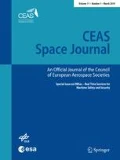Abstract
As space traffic increases, Space Situational Awareness (SSA) is becoming fundamental for safe spaceflight operations. Cost-driven missions based on small satellite platforms would benefit from the availability of alternative tools providing preliminary SSA from publicly available information, such as two-line elements. In this work, we propose an orbit prediction and uncertainty evaluation method based on the well-established TLE differencing technique aided by a machine learning corrector. By designing a Recurrent Neural Network with carefully chosen input parameters, the TLE prediction accuracy is significantly improved, when tested against precise orbital data of real satellites. The prediction error is reduced, on average, by 45% across a prediction window of 16 days which may include manoeuvres. We further show that in combination with a statistical test for equality between error distributions, the differencing technique applied to the corrected TLE allows a reliable variance estimate in most situations. Limitation of the work is the training of a dedicated neural network corrector for each specific space object, which will be deposed as part of our ongoing efforts.




Data availability
All data and information being necessary to understand the study are given in the manuscript.
Notes
Exploiting that the cumulants of the sum equals the sum of the cumulants for independent random variables.
A generalization of type II is the one involving neural network predictions for the same satellite, but at a different time-span, than what used for training,
References
DelPozzo, S., Williams, C.: Nano/microsatellite market forecast, 10th (eds.) Spacework Enterprises inc., (2020). https://www.spaceworks.aero/nano-microsatellite-forecast-10th-edition-2020/
Pearlman, M., Degnan, J., Boswort, J.: The international laser ranging service. Adv. Space Res. 30, 135–143 (2002). https://doi.org/10.1016/S0273-1177(02)00277-6
Vallado, D. A., Virgili, B, B., Flohrer, T.: Improved SSA through orbit determination of twoline element sets, 6th European conference on space debris. Doi: https://doi.org/10.13140/2.1.4644.2241 (2013)
Muelhaupt, T.J., Sorge, M.E., Morin, J., Wilson, R.S.: Space traffic management in the new space era. J. Space Saf. Eng. (2019). https://doi.org/10.1016/j.jsse.2019.05.007
Flohrer, T., Krag, H., Klinkrad, H.: Assessment and categorization of TLE orbit errors for the US SSN catalogue, risk, 8 pp, 10–11. (2008)
Legendre, P., Deguine, B., Garmier, R., Revelin, B.: Two line element accuracy assessment based on a mixture of gaussian laws, AIAA/AAS Astrodynamics specialist conference and exhibit. Doi: https://doi.org/10.2514/6.2006-6518(2006).
Geul, J., Mooij, E., Noomen, R.: TLE uncertainty estimation using robust weighted differencing. Adv. Space Res. 59, 2522–2535 (2017). https://doi.org/10.1016/j.asr.2017.02.038
Peng, H., Bai, X.: Gaussian processes for improving orbit prediction accuracy. Acta Astronaut. 162, 44–56 (2019). https://doi.org/10.1016/j.actaastro.2019.05.014
Peng, H., Bai, X.: Comparative evaluation of three machine learning algorithms on improving orbit prediction accuracy. Astrodynamics 3, 325–343 (2019). https://doi.org/10.1007/s42064-018-0055-4
Almosallam, I.: Heteroscedastic Gaussian Processes for Uncertain and Incomplete Data. Universisty of Oxford, Somerville College, Oxford (2017)
Mital, R., Cates, K., Coughlin, J., Ganji, G.: A machine learning approach to modeling satellite behavior. International conference on space mission challenges for information technology (SMC-IT). Doi: https://doi.org/10.1109/SMC-IT.2019.00013. (2019)
Yang, H-T., Zhu, J-P., Zhang, J.: The research of low earth orbit prediction of satellite based on deep neural network. 2nd International conference on computer, mechatronics and electronic engineering (CMEE 2017) (2017)
Vallado, D. A., Cefola, P.: Two-line element sets—practice and use. 63rd International astronautical congress. IAC-12-A6.6.11. (2012)
Peng, H., Bai, X.: Artificial Neural Network–based machine learning approach to improve orbit prediction accuracy. J. Spacecr. Rockets 55, 1248–1260 (2018). https://doi.org/10.2514/1.A34171
Sahoo, P.: Probability and mathematical statistics. Universisty of Louisville, Louisville (2013)
Tyahla, L. J.: International laser ranging service, consolidated prediction format (CPF). https://ilrs.gsfc.nasa.gov/data_and_products/formats/cpf.html. Accessed date 10 Dec 2020
Funding
This work received no funding.
Author information
Authors and Affiliations
Corresponding author
Ethics declarations
Conflict of interest
There are no conflicts of interest to disclose.
Additional information
Publisher's Note
Springer Nature remains neutral with regard to jurisdictional claims in published maps and institutional affiliations.
Rights and permissions
About this article
Cite this article
Curzi, G., Modenini, D. & Tortora, P. Two-line-element propagation improvement and uncertainty estimation using recurrent neural networks. CEAS Space J 14, 197–204 (2022). https://doi.org/10.1007/s12567-021-00375-3
Received:
Revised:
Accepted:
Published:
Issue Date:
DOI: https://doi.org/10.1007/s12567-021-00375-3

